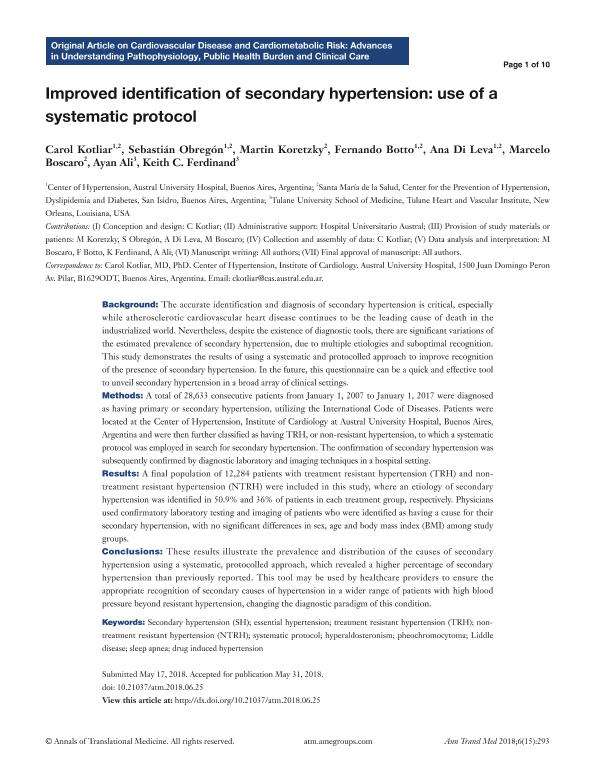Mostrar el registro sencillo del ítem
dc.contributor.author
Kotliar, Carol Virginia

dc.contributor.author
Obregón, Sebastián
dc.contributor.author
Koretzky, Martin
dc.contributor.author
Botto, Fernando
dc.contributor.author
Di Leva, Ana
dc.contributor.author
Boscaro, Marcelo
dc.contributor.author
Ali, Ayan
dc.contributor.author
Ferdinand, Keith C.
dc.date.available
2022-09-29T14:29:23Z
dc.date.issued
2018-08
dc.identifier.citation
Kotliar, Carol Virginia; Obregón, Sebastián; Koretzky, Martin; Botto, Fernando; Di Leva, Ana; et al.; Improved identification of secondary hypertension: use of a systematic protocol; AME Publishing Company; Annals of Translational Medicine; 6; 15; 8-2018; 293-293
dc.identifier.issn
2305-5839
dc.identifier.uri
http://hdl.handle.net/11336/171018
dc.description.abstract
Background: The accurate identification and diagnosis of secondary hypertension is critical, especially while atherosclerotic cardiovascular heart disease continues to be the leading cause of death in the industrialized world. Nevertheless, despite the existence of diagnostic tools, there are significant variations of the estimated prevalence of secondary hypertension, due to multiple etiologies and suboptimal recognition. This study demonstrates the results of using a systematic and protocolled approach to improve recognition of the presence of secondary hypertension. In the future, this questionnaire can be a quick and effective tool to unveil secondary hypertension in a broad array of clinical settings. Methods: A total of 28,633 consecutive patients from January 1, 2007 to January 1, 2017 were diagnosed as having primary or secondary hypertension, utilizing the International Code of Diseases. Patients were located at the Center of Hypertension, Institute of Cardiology at Austral University Hospital, Buenos Aires, Argentina and were then further classified as having TRH, or non-resistant hypertension, to which a systematic protocol was employed in search for secondary hypertension. The confirmation of secondary hypertension was subsequently confirmed by diagnostic laboratory and imaging techniques in a hospital setting. Results: A final population of 12,284 patients with treatment resistant hypertension (TRH) and nontreatment resistant hypertension (NTRH) were included in this study, where an etiology of secondary hypertension was identified in 50.9% and 36% of patients in each treatment group, respectively. Physicians used confirmatory laboratory testing and imaging of patients who were identified as having a cause for their secondary hypertension, with no significant differences in sex, age and body mass index (BMI) among study groups. Conclusions: These results illustrate the prevalence and distribution of the causes of secondary hypertension using a systematic, protocolled approach, which revealed a higher percentage of secondary hypertension than previously reported. This tool may be used by healthcare providers to ensure the appropriate recognition of secondary causes of hypertension in a wider range of patients with high blood pressure beyond resistant hypertension, changing the diagnostic paradigm of this condition.
dc.format
application/pdf
dc.language.iso
eng
dc.publisher
AME Publishing Company
dc.rights
info:eu-repo/semantics/openAccess
dc.rights.uri
https://creativecommons.org/licenses/by-nc-nd/2.5/ar/
dc.subject
SECONDARY HYPERTENSION
dc.subject
ESSENTIAL HYPERTENSION
dc.subject
TREATMENT RESISTANT HYPERTENSION (TRH)
dc.subject
NONTREATMENT RESISTANT HYPERTENSION (NTRH)
dc.subject
SYSTEMATIC PROTOCOL
dc.subject
HYPERALDOSTERONISM
dc.subject
PHEOCHROMOCYTOMA
dc.subject
LIDDLE DISEASE
dc.subject
SLEEP APNEA
dc.subject
DRUG INDUCED HYPERTENSION
dc.subject.classification
Sistemas Cardíaco y Cardiovascular

dc.subject.classification
Medicina Clínica

dc.subject.classification
CIENCIAS MÉDICAS Y DE LA SALUD

dc.title
Improved identification of secondary hypertension: use of a systematic protocol
dc.type
info:eu-repo/semantics/article
dc.type
info:ar-repo/semantics/artículo
dc.type
info:eu-repo/semantics/publishedVersion
dc.date.updated
2022-09-22T15:09:21Z
dc.identifier.eissn
2305-5847
dc.journal.volume
6
dc.journal.number
15
dc.journal.pagination
293-293
dc.journal.pais
Hong Kong

dc.description.fil
Fil: Kotliar, Carol Virginia. Consejo Nacional de Investigaciones Científicas y Técnicas; Argentina. Universidad Austral. Hospital Universitario Austral; Argentina. Santa María de la Salud; Argentina
dc.description.fil
Fil: Obregón, Sebastián. Universidad Austral. Hospital Universitario Austral; Argentina. Santa María de la Salud; Argentina
dc.description.fil
Fil: Koretzky, Martin. Santa María de la Salud; Argentina
dc.description.fil
Fil: Botto, Fernando. Universidad Austral. Hospital Universitario Austral; Argentina. Santa María de la Salud; Argentina
dc.description.fil
Fil: Di Leva, Ana. Universidad Austral. Hospital Universitario Austral; Argentina. Santa María de la Salud; Argentina
dc.description.fil
Fil: Boscaro, Marcelo. Santa María de la Salud; Argentina
dc.description.fil
Fil: Ali, Ayan. University of Tulane; Estados Unidos
dc.description.fil
Fil: Ferdinand, Keith C.. University of Tulane; Estados Unidos
dc.journal.title
Annals of Translational Medicine
dc.relation.alternativeid
info:eu-repo/semantics/altIdentifier/url/http://atm.amegroups.com/article/view/20388
dc.relation.alternativeid
info:eu-repo/semantics/altIdentifier/doi/http://dx.doi.org/10.21037/atm.2018.06.25
Archivos asociados
